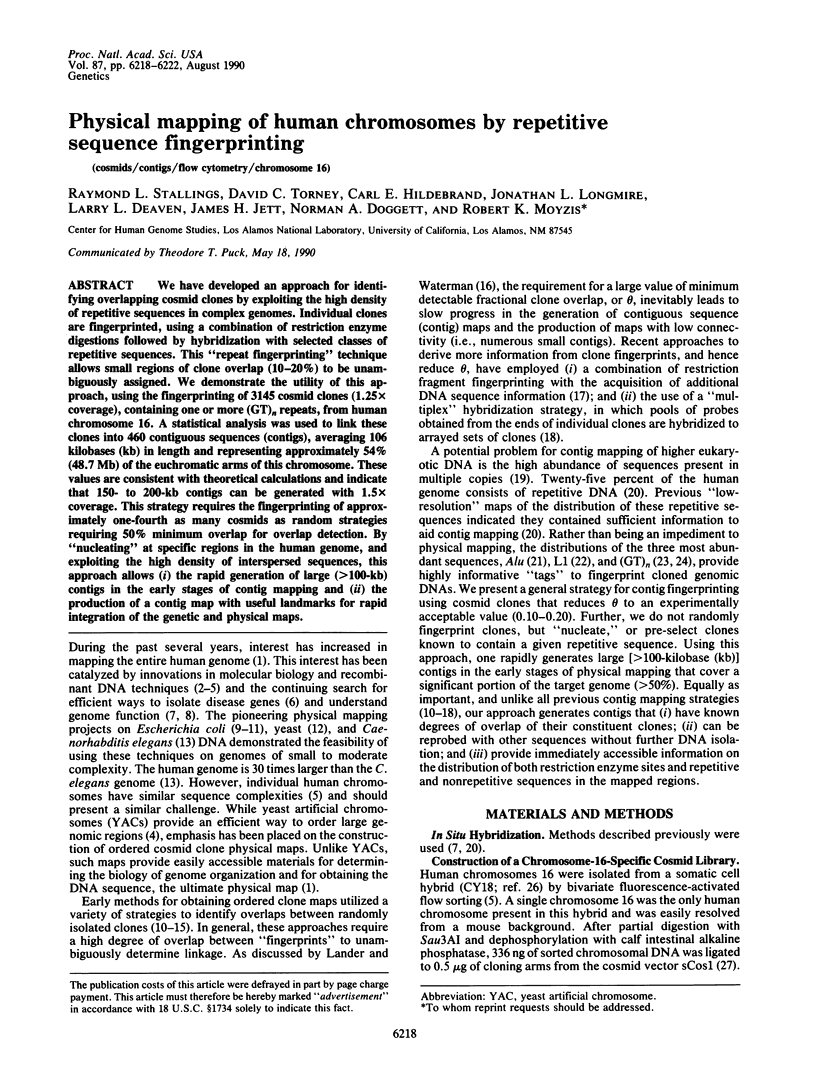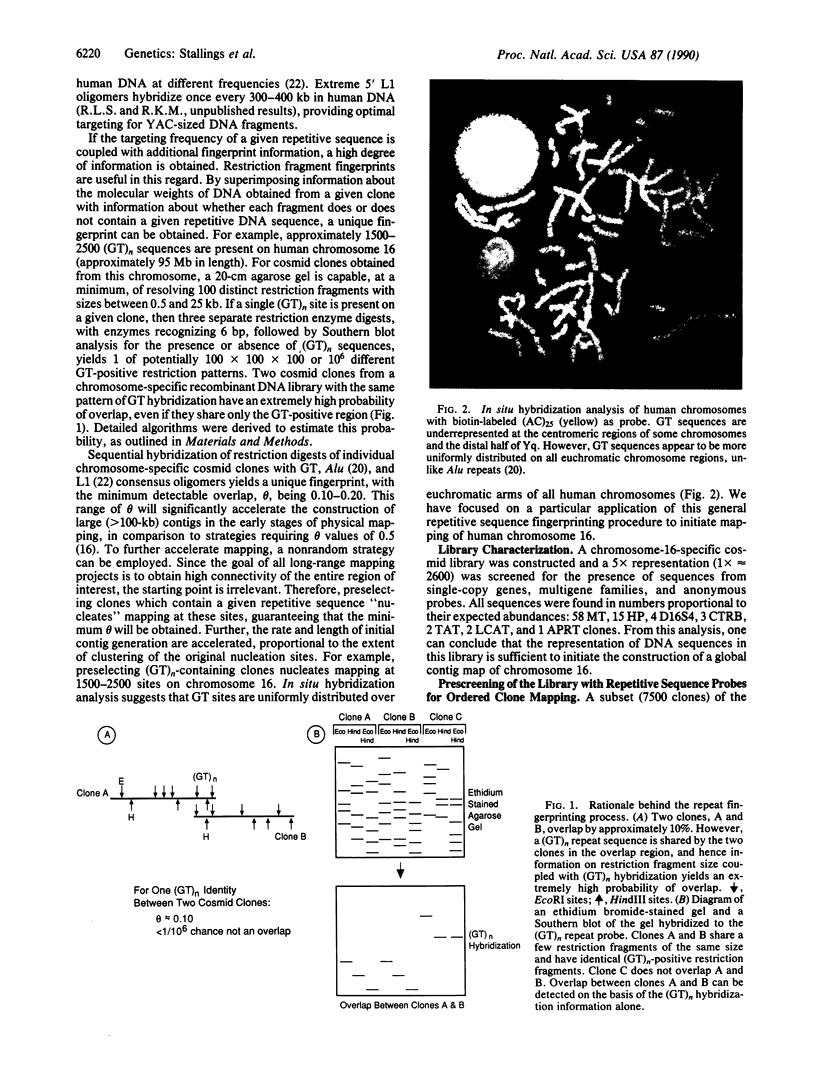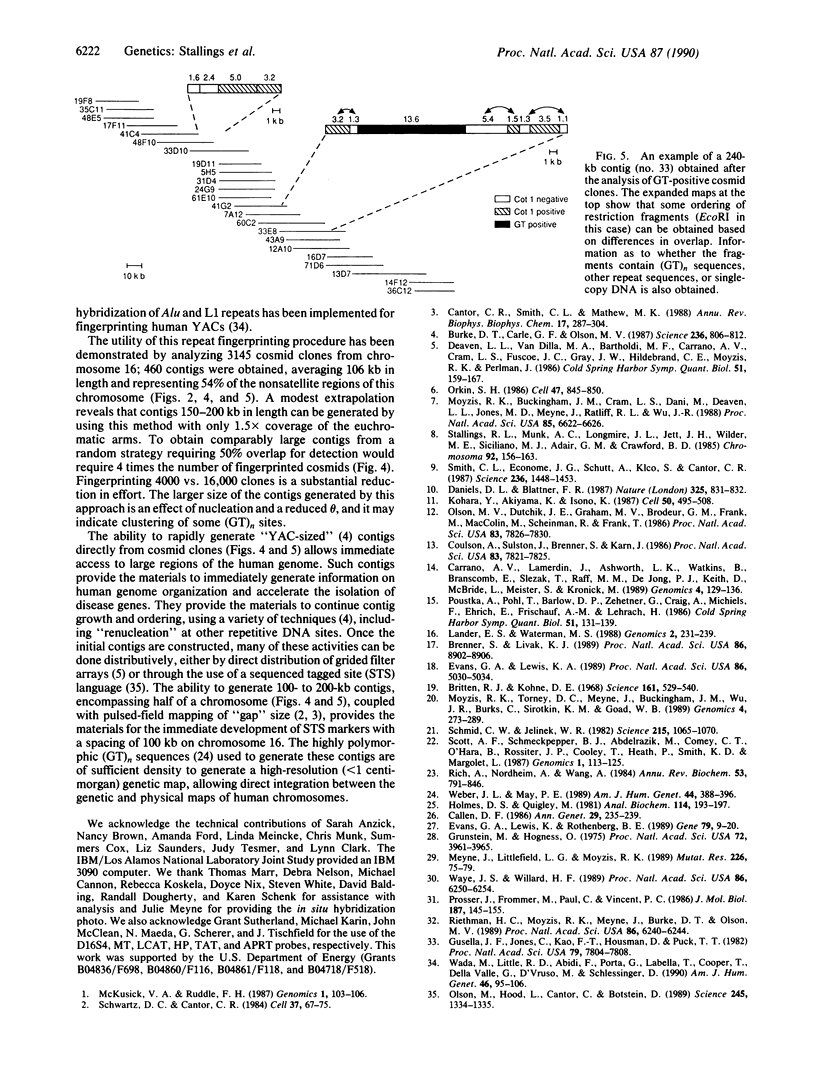Abstract
We have developed an approach for identifying overlapping cosmid clones by exploiting the high density of repetitive sequences in complex genomes. Individual clones are fingerprinted, using a combination of restriction enzyme digestions followed by hybridization with selected classes of repetitive sequences. This "repeat fingerprinting" technique allows small regions of clone overlap (10-20%) to be unambiguously assigned. We demonstrate the utility of this approach, using the fingerprinting of 3145 cosmid clones (1.25 x coverage), containing one or more (GT)n repeats, from human chromosome 16. A statistical analysis was used to link these clones into 460 contiguous sequences (contigs), averaging 106 kilobases (kb) in length and representing approximately 54% (48.7 Mb) of the euchromatic arms of this chromosome. These values are consistent with theoretical calculations and indicate that 150- to 200-kb contigs can be generated with 1.5 x coverage. This strategy requires the fingerprinting of approximately one-fourth as many cosmids as random strategies requiring 50% minimum overlap for overlap detection. By "nucleating" at specific regions in the human genome, and exploiting the high density of interspersed sequences, this approach allows (i) the rapid generation of large (greater than 100-kb) contigs in the early stages of contig mapping and (ii) the production of a contig map with useful landmarks for rapid integration of the genetic and physical maps.
Full text
PDF




Images in this article
Selected References
These references are in PubMed. This may not be the complete list of references from this article.
- Brenner S., Livak K. J. DNA fingerprinting by sampled sequencing. Proc Natl Acad Sci U S A. 1989 Nov;86(22):8902–8906. doi: 10.1073/pnas.86.22.8902. [DOI] [PMC free article] [PubMed] [Google Scholar]
- Britten R. J., Kohne D. E. Repeated sequences in DNA. Hundreds of thousands of copies of DNA sequences have been incorporated into the genomes of higher organisms. Science. 1968 Aug 9;161(3841):529–540. doi: 10.1126/science.161.3841.529. [DOI] [PubMed] [Google Scholar]
- Burke D. T., Carle G. F., Olson M. V. Cloning of large segments of exogenous DNA into yeast by means of artificial chromosome vectors. Science. 1987 May 15;236(4803):806–812. doi: 10.1126/science.3033825. [DOI] [PubMed] [Google Scholar]
- Callen D. F. A mouse-human hybrid cell panel for mapping human chromosome 16. Ann Genet. 1986;29(4):235–239. [PubMed] [Google Scholar]
- Cantor C. R., Smith C. L., Mathew M. K. Pulsed-field gel electrophoresis of very large DNA molecules. Annu Rev Biophys Biophys Chem. 1988;17:287–304. doi: 10.1146/annurev.bb.17.060188.001443. [DOI] [PubMed] [Google Scholar]
- Carrano A. V., Lamerdin J., Ashworth L. K., Watkins B., Branscomb E., Slezak T., Raff M., de Jong P. J., Keith D., McBride L. A high-resolution, fluorescence-based, semiautomated method for DNA fingerprinting. Genomics. 1989 Feb;4(2):129–136. doi: 10.1016/0888-7543(89)90291-7. [DOI] [PubMed] [Google Scholar]
- Coulson A., Sulston J., Brenner S., Karn J. Toward a physical map of the genome of the nematode Caenorhabditis elegans. Proc Natl Acad Sci U S A. 1986 Oct;83(20):7821–7825. doi: 10.1073/pnas.83.20.7821. [DOI] [PMC free article] [PubMed] [Google Scholar]
- Daniels D. L., Blattner F. R. Mapping using gene encyclopaedias. 1987 Feb 26-Mar 4Nature. 325(6107):831–832. doi: 10.1038/325831a0. [DOI] [PubMed] [Google Scholar]
- Deaven L. L., Van Dilla M. A., Bartholdi M. F., Carrano A. V., Cram L. S., Fuscoe J. C., Gray J. W., Hildebrand C. E., Moyzis R. K., Perlman J. Construction of human chromosome-specific DNA libraries from flow-sorted chromosomes. Cold Spring Harb Symp Quant Biol. 1986;51(Pt 1):159–167. doi: 10.1101/sqb.1986.051.01.019. [DOI] [PubMed] [Google Scholar]
- Evans G. A., Lewis K. A. Physical mapping of complex genomes by cosmid multiplex analysis. Proc Natl Acad Sci U S A. 1989 Jul;86(13):5030–5034. doi: 10.1073/pnas.86.13.5030. [DOI] [PMC free article] [PubMed] [Google Scholar]
- Evans G. A., Lewis K., Rothenberg B. E. High efficiency vectors for cosmid microcloning and genomic analysis. Gene. 1989 Jun 30;79(1):9–20. doi: 10.1016/0378-1119(89)90088-7. [DOI] [PubMed] [Google Scholar]
- Grunstein M., Hogness D. S. Colony hybridization: a method for the isolation of cloned DNAs that contain a specific gene. Proc Natl Acad Sci U S A. 1975 Oct;72(10):3961–3965. doi: 10.1073/pnas.72.10.3961. [DOI] [PMC free article] [PubMed] [Google Scholar]
- Gusella J. F., Jones C., Kao F. T., Housman D., Puck T. T. Genetic fine-structure mapping in human chromosome 11 by use of repetitive DNA sequences. Proc Natl Acad Sci U S A. 1982 Dec;79(24):7804–7808. doi: 10.1073/pnas.79.24.7804. [DOI] [PMC free article] [PubMed] [Google Scholar]
- Holmes D. S., Quigley M. A rapid boiling method for the preparation of bacterial plasmids. Anal Biochem. 1981 Jun;114(1):193–197. doi: 10.1016/0003-2697(81)90473-5. [DOI] [PubMed] [Google Scholar]
- Kohara Y., Akiyama K., Isono K. The physical map of the whole E. coli chromosome: application of a new strategy for rapid analysis and sorting of a large genomic library. Cell. 1987 Jul 31;50(3):495–508. doi: 10.1016/0092-8674(87)90503-4. [DOI] [PubMed] [Google Scholar]
- Lander E. S., Waterman M. S. Genomic mapping by fingerprinting random clones: a mathematical analysis. Genomics. 1988 Apr;2(3):231–239. doi: 10.1016/0888-7543(88)90007-9. [DOI] [PubMed] [Google Scholar]
- McKusick V. A., Ruddle F. H. Toward a complete map of the human genome. Genomics. 1987 Oct;1(2):103–106. doi: 10.1016/0888-7543(87)90001-2. [DOI] [PubMed] [Google Scholar]
- Meyne J., Littlefield L. G., Moyzis R. K. Labeling of human centromeres using an alphoid DNA consensus sequence: application to the scoring of chromosome aberrations. Mutat Res. 1989 Jun;226(2):75–79. doi: 10.1016/0165-7992(89)90046-8. [DOI] [PubMed] [Google Scholar]
- Moyzis R. K., Buckingham J. M., Cram L. S., Dani M., Deaven L. L., Jones M. D., Meyne J., Ratliff R. L., Wu J. R. A highly conserved repetitive DNA sequence, (TTAGGG)n, present at the telomeres of human chromosomes. Proc Natl Acad Sci U S A. 1988 Sep;85(18):6622–6626. doi: 10.1073/pnas.85.18.6622. [DOI] [PMC free article] [PubMed] [Google Scholar]
- Moyzis R. K., Torney D. C., Meyne J., Buckingham J. M., Wu J. R., Burks C., Sirotkin K. M., Goad W. B. The distribution of interspersed repetitive DNA sequences in the human genome. Genomics. 1989 Apr;4(3):273–289. doi: 10.1016/0888-7543(89)90331-5. [DOI] [PubMed] [Google Scholar]
- Olson M. V., Dutchik J. E., Graham M. Y., Brodeur G. M., Helms C., Frank M., MacCollin M., Scheinman R., Frank T. Random-clone strategy for genomic restriction mapping in yeast. Proc Natl Acad Sci U S A. 1986 Oct;83(20):7826–7830. doi: 10.1073/pnas.83.20.7826. [DOI] [PMC free article] [PubMed] [Google Scholar]
- Orkin S. H. Reverse genetics and human disease. Cell. 1986 Dec 26;47(6):845–850. doi: 10.1016/0092-8674(86)90799-3. [DOI] [PubMed] [Google Scholar]
- Poustka A., Pohl T., Barlow D. P., Zehetner G., Craig A., Michiels F., Ehrich E., Frischauf A. M., Lehrach H. Molecular approaches to mammalian genetics. Cold Spring Harb Symp Quant Biol. 1986;51(Pt 1):131–139. doi: 10.1101/sqb.1986.051.01.016. [DOI] [PubMed] [Google Scholar]
- Prosser J., Frommer M., Paul C., Vincent P. C. Sequence relationships of three human satellite DNAs. J Mol Biol. 1986 Jan 20;187(2):145–155. doi: 10.1016/0022-2836(86)90224-x. [DOI] [PubMed] [Google Scholar]
- Rich A., Nordheim A., Wang A. H. The chemistry and biology of left-handed Z-DNA. Annu Rev Biochem. 1984;53:791–846. doi: 10.1146/annurev.bi.53.070184.004043. [DOI] [PubMed] [Google Scholar]
- Riethman H. C., Moyzis R. K., Meyne J., Burke D. T., Olson M. V. Cloning human telomeric DNA fragments into Saccharomyces cerevisiae using a yeast-artificial-chromosome vector. Proc Natl Acad Sci U S A. 1989 Aug;86(16):6240–6244. doi: 10.1073/pnas.86.16.6240. [DOI] [PMC free article] [PubMed] [Google Scholar]
- Schmid C. W., Jelinek W. R. The Alu family of dispersed repetitive sequences. Science. 1982 Jun 4;216(4550):1065–1070. doi: 10.1126/science.6281889. [DOI] [PubMed] [Google Scholar]
- Schwartz D. C., Cantor C. R. Separation of yeast chromosome-sized DNAs by pulsed field gradient gel electrophoresis. Cell. 1984 May;37(1):67–75. doi: 10.1016/0092-8674(84)90301-5. [DOI] [PubMed] [Google Scholar]
- Scott A. F., Schmeckpeper B. J., Abdelrazik M., Comey C. T., O'Hara B., Rossiter J. P., Cooley T., Heath P., Smith K. D., Margolet L. Origin of the human L1 elements: proposed progenitor genes deduced from a consensus DNA sequence. Genomics. 1987 Oct;1(2):113–125. doi: 10.1016/0888-7543(87)90003-6. [DOI] [PMC free article] [PubMed] [Google Scholar]
- Smith C. L., Econome J. G., Schutt A., Klco S., Cantor C. R. A physical map of the Escherichia coli K12 genome. Science. 1987 Jun 12;236(4807):1448–1453. doi: 10.1126/science.3296194. [DOI] [PubMed] [Google Scholar]
- Stallings R. L., Munk A. C., Longmire J. L., Jett J. H., Wilder M. E., Siciliano M. J., Adair G. M., Crawford B. D. Oncogenes and linkage groups: conservation during mammalian chromosome evolution. Chromosoma. 1985;92(2):156–163. doi: 10.1007/BF00328468. [DOI] [PubMed] [Google Scholar]
- Wada M., Little R. D., Abidi F., Porta G., Labella T., Cooper T., Della Valle G., D'Urso M., Schlessinger D. Human Xq24-Xq28: approaches to mapping with yeast artificial chromosomes. Am J Hum Genet. 1990 Jan;46(1):95–106. [PMC free article] [PubMed] [Google Scholar]
- Waye J. S., Willard H. F. Human beta satellite DNA: genomic organization and sequence definition of a class of highly repetitive tandem DNA. Proc Natl Acad Sci U S A. 1989 Aug;86(16):6250–6254. doi: 10.1073/pnas.86.16.6250. [DOI] [PMC free article] [PubMed] [Google Scholar]
- Weber J. L., May P. E. Abundant class of human DNA polymorphisms which can be typed using the polymerase chain reaction. Am J Hum Genet. 1989 Mar;44(3):388–396. [PMC free article] [PubMed] [Google Scholar]






